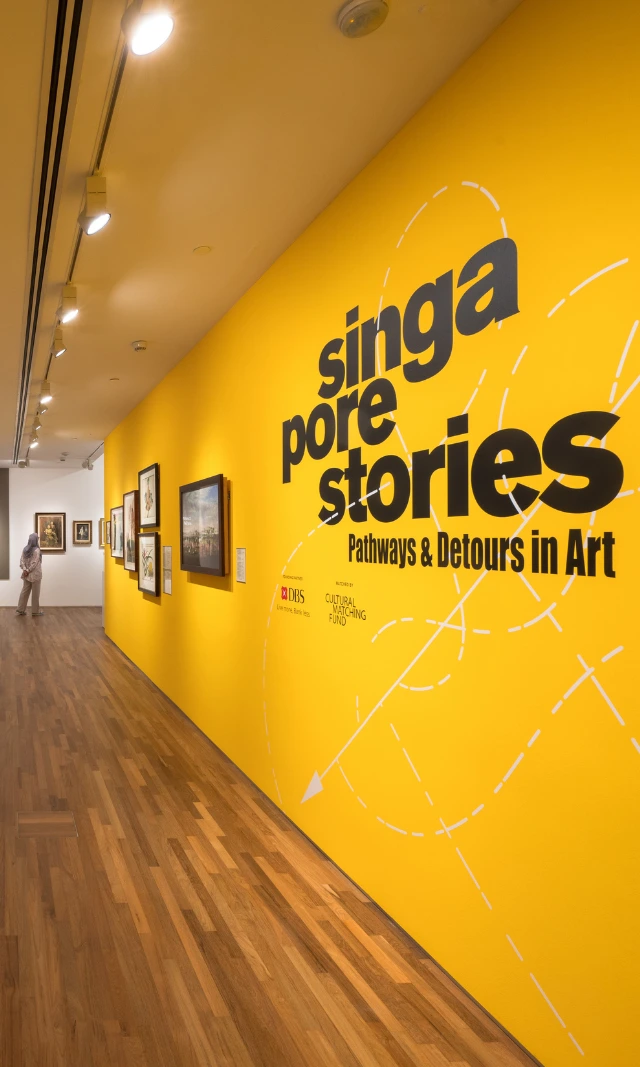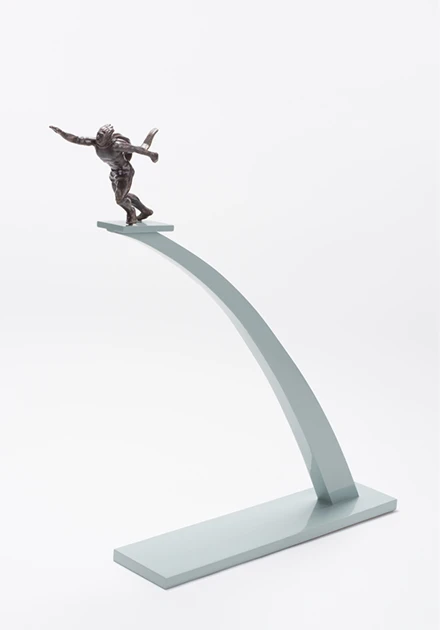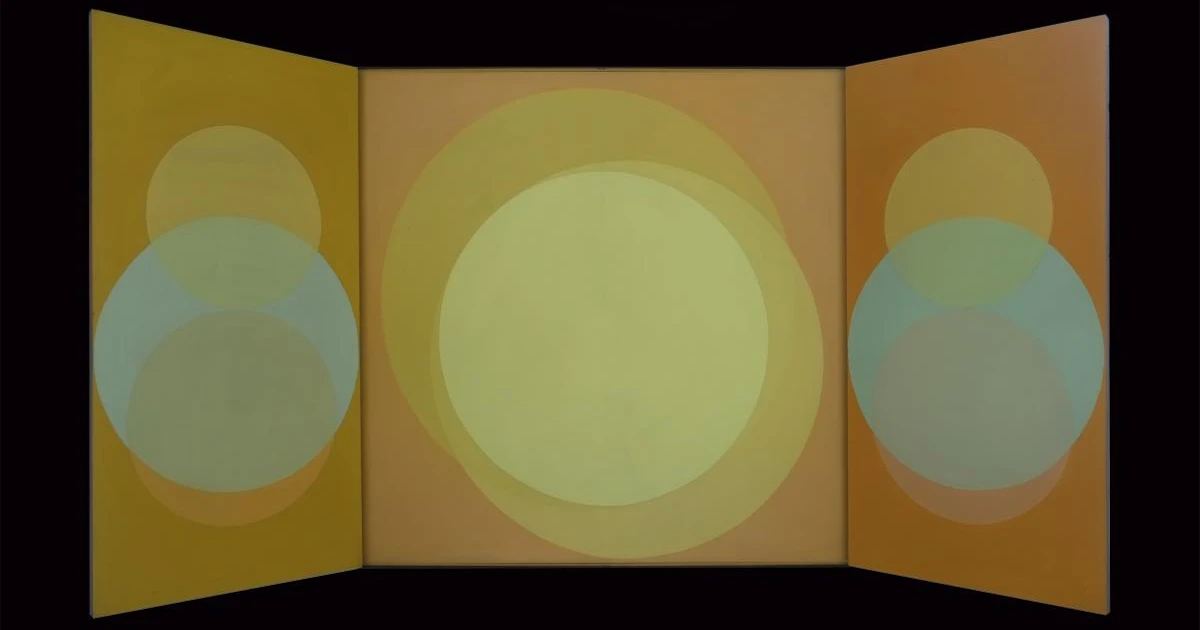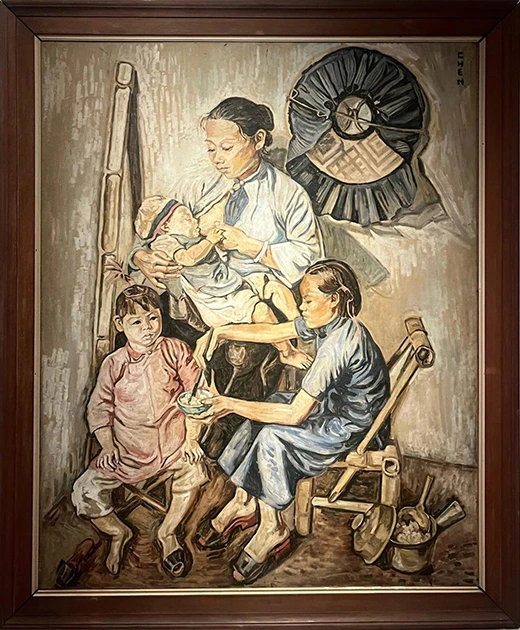Local Futurisms and Extractive Pasts
The "Virgen de Cerro Rico" is an anonymous painting from the 1600s commemorating the Spanish Crown's discovery of this silver-rich mountain in 1545. This discovery not only established a new form of mining, but also made human and non-human exploitation the organising principle of the new world. Sofia Dourron (Associate Curator, 12th Seoul Mediacity Biennale) interrogates how this work, and other contemporary ones featured in the Biennale, can help us go beyond the "extractive view" of territoriality.
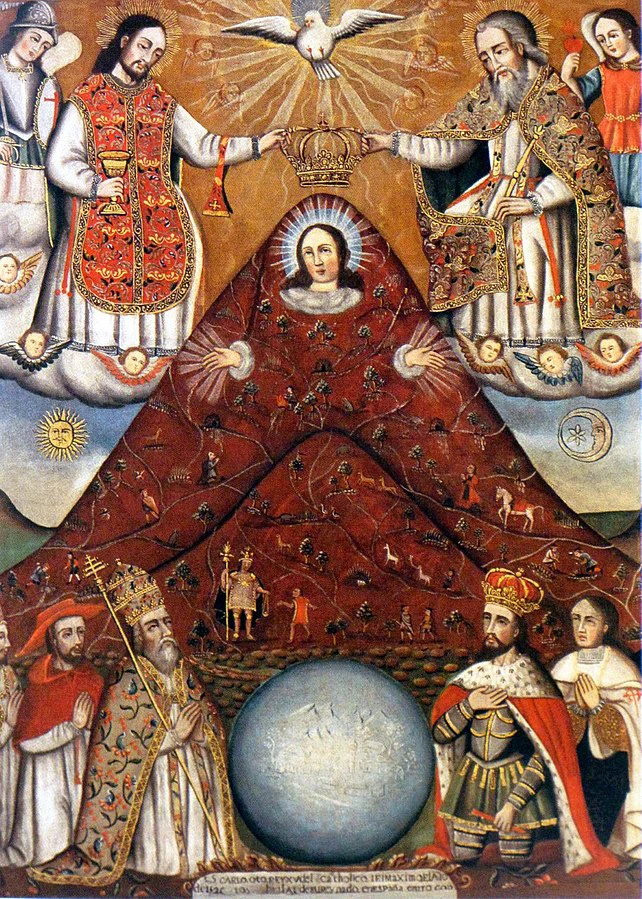
Virgen de Cerro Rico
c. 1680
La Casa Nacional de Moneda de Bolivia
Image credit: PMRMaeyaert, CC BY-SA 4.0
<https://creativecommons.org/licenses/by-sa/4.0>, via Wikimedia Commons
An enormous Virgin-Mountain-Woman features at the center of Virgen de Cerro Rico, an anonymous Hispano-American baroque painting from circa 1680 currently located at the Casa Nacional de Moneda, Bolivia. The figure could be understood as being at the center of this mid-sixteenth century world—she is flanked at the top by the Holy Trinity, St Michael, St Raphael and a string of cherubs; in the middle by the sun and the moon; and at the bottom, Pope Paul III and other members of the Christian church stand on one side, with Charles V and the Cacique Inca (the commissioner of the work) on the other. The painting can also be read chronologically from top to bottom; that is, the Trinity existed prior to Mary, who in turn lived before the Inca that preceded the characters located at the foot of the hill. Read like this, the painting pictorially maps colonial power.1
The painting commemorated the discovery of the Cerro Rico in Potosí2 and sanctified colonised economic patrimony through Marian devotion. The Pachamama-huaca-Virgin3 Mary, a combination of Andean Mother Earth—a sacred pre-Hispanic entity—and Christian worship imagery, stands on a globe that symbolises the universality of Christianity. However, her body and habit, different to most, is made of the cerro itself, with its meandering paths, deep silver veins, and human and non-human inhabitants.4 The powerful image speaks to the centrality of the Cerro Rico and the city of Potosí to the colonial enterprise and its evangelical counterpart. Apart from its more standard art-historical analyses, the painting depicts the critical role the exploitation of the cerro had in forging colonial expansion, and its links to the origins of extraction, western technology and rational science, all of which have converged to create an impetus for a global conquest of space, bodies and resources.
The painting is historically undergirded, as scholar Macarena Gómez-Barris points out, by the enslaved eight million Indigenous and thirty thousand African peoples who worked in the mines of Cerro Rico, and the one million people whose remains are still buried in it.5 Contradicting its function as an artifact of religious devotion and historical record, the image also manages to bring together a fractured world, with the dress/female body mapping the mountain world and showing the path toward the reciprocity embodied by the Pachamama. When retroactively encountering the Virgen de Cerro Rico in the 21st century armed with the knowledge of its absences, the painting offers the possibility of bridging the distance between nature and culture, human and non-human beings, development and sustainability, imagining in place of its original interpretations, not one, but multiple forms of futurism. This essay explores these notions as they are presented in the 12th Seoul Mediacity Biennale (SMB12) project, THIS TOO, IS A MAP, finding a path through the colonial and political histories of extraction to the realms of contemporary Southeast Asian and Andean futurisms and aesthetics. The project aims to do so by exploring the deep connections between colonial histories, cartographies and environmental thinking, and from what Gómez-Barris calls “submerged perspectives.” These alternative forms of perceiving encourage underground connections across geographies and space-time coordinates, allowing for a perception of local terrains as sources of knowledge, vitality and livability.6
The discovery of Cerro Rico in 1545 during the conquest of America by the Spanish Crown not only established a new form of mining but turned human and non-human exploitation into the organising principle of the new world. This colossal operation emerges as the “epistemic-political device constituting the “New World,” which encompasses not only the entity “America,” but also “Europe,” “the West,” “Modernity,” and capitalism as a hegemonic world-ecosystem.”7 It provoked a profound geological, political, social and ecological fracture, creating a regime of world power based on massive global ecological turmoil and the systemic violation of the human condition. If mining was an exclusively military activity during the early years of conquest, based on a scorched-earth policy that ended as soon as the availability of labouring bodies had been exhausted, the discovery of the Cerro Rico mines was a turning point that meant that “conquest mining” had to be reformulated into a colonisation operation to sustain itself. It not only evolved from superficial into industrial underground mining, but also built a system based on political, technological, scientific, religious and anthropological engineering to justify and perform this transformation. At an altitude of 4,090 metres, Potosí is one of the highest cities in the world—with its extreme climatic conditions, scant population, and limited water supply and energy resources, the extraction of silver from Cerro Rico proved to be a significant eco-political challenge. The enterprise required the development of a set of far-reaching social and environmental technologies, including systems to control and maintain a massive labour force; the bureaucratic and legal administration, management, control and disposition of bodies and objects; immense infrastructure, technological, and engineering projects and innovations for roads, energy, storage, and transportation; and an indiscriminate tree-felling venture that provided enough biomass to fuel mineral and human exploitation for years and transformed the city into a huge forest-consuming furnace.8
The mining revolution and conquest of nature in Potosí during the second half of the 16th century reveal the complex entanglement of coloniality, early ecological trauma associated with multiple forms of extractivism, the development of science and technology, and the dawn of global Capitalism. These modern-colonial histories, epistemologies, and global politics and economics have since then produced a set of colonial fractures that, as environmental engineer Malcom Ferdinand notes:
Separate nature and culture, environment and society, establishing a vertical scale of values that places “Man” above nature. This fracture is revealed through the technical, scientific and economic modernizations of the mastery of nature, the effects of which can be measured by the extent of the Earth’s pollution, the loss of biodiversity, global warming, and the associated persistence of gender inequality, social misery, and the "disposable lives" that are thereby created.9
This separation of the colonial and environmental history of the world hides the mineral base of modern imperial power as well as the colonial origins of the extractivist project, which began to develop a specific structure with the conquest and colonisation of America, Africa and Asia. Projects like Potosí expanded globally, with mining in Africa beginning in the early 19th century, the exploitation of subsoil of Aboriginal lands in Australia as well as the First Nations in Canada and in the US, the mining of uranium in South Africa to power the nuclear race in the early 20th century, and the land grabbing and extractivist projects in Southeast Asia in the 21st century, from logging, palm oil plantations, gold, coal and nickel mining to oil and gas extraction, among other forms of extraction across multiple time-space coordinates. The global extraction of rare earth metals like lithium and cobalt that fuel technology-driven development across the world and the planning, research and scientific development that enables the extraction of deep-sea polymetallic nodules ensure the continuation of this model into the future. It also maintains the flow of minerals and labour, which are extracted from territories and subsequently transported to other distant geographical destinations, for processing and consumption. What they leave behind are depleted lands, above and below ground, and bodies that are either forced into an unsustainable form of “colonial inhabitation”10 or made to migrate to uncertain destinations under unpredictable conditions.
Part of the exhibition, anthology and programmes that make up THIS TOO, IS A MAP explores how the manifestations of these resonances across regions and temporalities lead to the configuration of multi-temporal, multi-situated and ever-changing forms of mapping. These forms oppose the rigid geological, political, and economic cartographies that we inhabit today and that have, for centuries, placed territories and forms of being, sensing, and living into unyielding categories. Several works showcased in the exhibition perform a reversal of what Macarena Gómez-Barris has named the “extractive view”11 of territoriality —which sees territories as commodities, disregarding the human and non-human worlds that inhabit them—and the concurrent demand for epistemological unmooring, potentially transforming the way we relate to the land and its social and ecological worlds.
The colonial fracture is at the center of Peruvian artist Ximena Garrido-Lecca’s transhistorical and transdisciplinary practice. Though situated in the tensions between Andean cosmogonies, histories and traditions, and modern-colonial epistemologies and capitalist reproductive systems, her work is concerned with global struggles for resources and the never-ending geologic, economic and social loop that keeps these zones “trapped in a perverse state of affairs known in specialist literature as ‘the paradox of plenty’ or ‘the resource curse.’”12 In several of Garrido-Lecca’s works, the techniques and traditions from Andean civilisations are confronted with industrial processes and materials, foregrounding the different cultural temporalities that exist in the same space. Garrido-Lecca explores these epistemological and material relationships to build paths towards a form of Andean futurism that recovers pre-Columbian technologies, re-engineers Western science, and projects them into the future. Her sculpture Protomorphisms: AGC Rope Driver Module (2022), presented at SMB12, is a reconstruction and reimagination of an engineering prototype for the Apollo Guidance Computer (AGC), a cybernetic wonder and a critical component of the Apollo space programme. This technology provided the necessary calculation capacity to control the orientation and navigation of the first command and lunar modules. Developed in the early 1960s by the MIT Instrumentation Laboratory, the AGC was also one of the first computers to use silicon integrated circuits. It flew on fifteen manned missions, including nine Moon flights, six lunar landings, three Skylab missions, and the Apollo-Soyuz Test Mission in 1975.
Most of the software on the AGC was stored in a special read-only memory known as “core rope memory,” created by weaving wires through and around magnetic cores. Garrido-Lecca worked with engineers to translate the wiring schematics of the Rope Driver Module from the AGC manual, replicating the routes and connections of each cable with hand-made ropes of natural fibers from Peru and Mexico—cotton, and alpaca and sheep wool. The piece contrasts modern technology with pre-Hispanic data storage systems like the quipu—a system of writing and record-keeping with knots and colored threads that was created in the Andes more than 5,000 years ago and used until the European colonisers prohibited its use—and other forms of weaving of abstract languages that served as memory and communication devices. The base of the structure is made of copper plates, a material the artist often uses as a symbol to reflect the impact this material has on the Peruvian economy and its culture. The overlap and entanglements of those modern technologies used as navigation tools to conquer and map outer space are re-engineered with the elements traditionally used for Andean form of cartography on a metal that was the source of colonial extraction at the turning point of the mapping of the world. This amalgam of events above and below ground creates a liminal space in between colonial and spatial mappings, challenging dominant extractive economies through Andean cosmotechnics.13 The work reconsiders material, linguistic and technological entities and their relationships in the formation of worldviews, offering a compass to look up at the sky as a way of understanding the planet in which we live.
Another form of understanding the world is manifested in the contemporary and digitally born Southeast Asian futurism and world-building found in Natasha Tontey’s work at SMB12. Drawing inspiration from her own ancestral culture, Tontey creates digital animations, performances and installations that rely upon speculative fiction to explore Indonesia’s historical narratives, local myths and traditions, and contemporary cultures of fear. Through the research and speculation around animistic cosmologies, she creates queer narratives that challenge modern and capitalistic world-systems while rendering the outcasted, human and non-human the protagonists of the world to come. Children of the Stones Number Two (2023) combines two of Tontey’s previous works—The Epoch of Mapalucene and Wa’anak Witu Watu—into a short video that foregrounds the religious and spiritual practices of Indonesia’s North Sulawesi province and focuses on the distinctive worldview of the Minahasa tribe. With this, Tontey re-imagines the world through the lens of reciprocity, questioning the extractive view by ways of an imaginary geological period she calls the “Mapalucene.” To construct this speculative universe, the artist drew on her research into the indigenous practices of the Minahasa tribe in which the stone, a geo-entity with which human beings communicate, is celebrated as an integral part of society: “an elixir, God, a means to philosophising, gender expression, and sacred object.”14 She opposes this conception of stones with the modern-colonial worldview that engages with this non-human entity as a resource to be exploited; specimens to be dissected, categorised and investigated; a commodity to be traded; an expensive ornament to be exhibited; or an obstacle in the path towards progress to be demolished or ignored.
According to Tontey, the Mapalucene is organised around the alliances and solidarities between the human and non-human inhabitants of the Earth and is conceived based on Minahasan cosmology, philosophy, and stone-based systems, the latter of which is a result of the encounter between their ancient spiritual practices and Western capitalist ideas. The artist’s construction and conception of a speculative geologic period using the tools and aesthetics of an extraction-driven digital culture and the exploration of indigenous conceptions of the world sheds light on the colonial conditions underlying the production of technology and knowledge that make our capitalist-world-system possible. The contradictions and complex entanglements that make up Tontey’s work challenge colonial fractures and, aiming the colonisers’ artillery back towards them to imagine an alternative society where "all transactions between the earthlings will be established from the notion of a gift economy. Commidity, in this case, material and labour, will be distributed collectively with a peer-to-peer system. By doing this, no one extracts or exploits another. No one masters another.”15 In light of urgent ecological changes for sustainable futures, Tontey—without romanticising the Minahasa or creating a utopia based on a reoccurrence of the past—reflects on the potential of the entanglement between the artificial and the organic, the spiritual and the earthly, traditional rituals and modern aesthetics, employing a submerged vision that sheds light on the possible alliances for a decolonial critique of technology and extraction.
This critique, however, would not be possible without the intersection of race, class, and gender being at the core of Garrido-Lecca's and Tontey's. As Gómez-Barris notices upon her encounter with the Virgen de Cerro Rico painting, the image presents not only a Virgin and a Pachamama—she’s also a mestiza.16 María Lugones also comments on how we can make visible the long-term processes of the colonial/modern gender system that remains entangled in the coloniality of power in the present day: “We need to understand the organization of the social so as to make visible our collaboration with systematic racialized gender violence, so as to come to an inevitable recognition of it in our maps of reality."17 The works of Garrido-Lecca and Tontey at SMB12 make these systems visible by bringing forth the role of women and queer people in the reconsideration of the epistemologies of the past and the construction of potential futures. In Protomorphisms: AGC Rope Driver Module, Garrido-Lecca posits how different weaving practices and women weavers were essential to the development of the core rope memory and the data storage technologies that used them, creating connections between these innovations and the figures of moon goddesses and defenders of women: Mama Killa in Inca culture, Coyolxauhqui for the Aztecs, and Ixchel (a goddess of both the moon and textiles) in Mayan culture. Tontey, on the other hand, explores the Minahasan myth that poses that the first person ever to exist was a woman who gave birth through a stone, the origin story for the tribe’s cosmology, and the Karai ceremonies that grant warriors armour of invincibility; these are used to establish a queering approach towards gender, youth and ecology.
Against the backdrop of the global environmental crisis, a multitude of social injustices, and cultural, human, and mineral displacements, both artists create visual manifestations of the historical and contemporary aftereffects of colonial and modern state-led developments that continue to exclude indigenous and marginalised peoples—and all of those who are not accounted for in the maps of progress—from their own space of life. Operating on two opposite sides of the world—Latin America and Southeast Asia—their proposals come together in a way that conceives of local futurisms which can recover histories, materials and non-western epistemologies, cosmologies and ontologies. Such knowledge is critical for the development of science, technology, and knowledge that is oriented towards global designs. The proposals do not imagine re-establishing a supposed pre-colonial condition of the land, or call for a return to ancestral spiritual practices; in their works, there is no going back to an alleged “original state.” On the contrary, they provide a set of tools, ideas, and aesthetics to build on the ruins of colonialism through acts of care and reciprocity, moving us “to consider realms of differently organized reality that are linked to, yet move outside of, colonial boundaries.”18
Notes
- Yamile Ferreira, “Feminismo y descolonización: una mirada a la performance Virgen del Cerro de María Galindo,” in VII Jornadas Académicas de la Facultad de Humanidades y Ciencias de la Educación (Montevideo: FHUCE, 2017), 1318.
- Cerro Rico is a mountain in Potosí, Bolivia, originally rich in silver. Cerro Rico was the first, and remains the largest, mining venture undertaken by the Spanish Crown in America since the Crown began its extraction of mineral ores in 1545.
- Pachamama is the aymara and quichua name of a deity that represents the Earth in Andean indigenous cultures. She is an ever-present deity who controls fertility, presides over planting and harvesting, and has the creative power to sustain life on earth and take it away.
- The symbolic association of Virgin Mary and the mountain precedes colonisation. In that sense, it could be said that the painting responds to an evangelising need that illustrates the Catholic doctrine and the possibility of adoration through accumulable blessed capital—in this case, natural resources. However, Teresa Gisbert posits that in the Andes, and in this particular case Mary, substitutes the spirits of the mountains, identifying herself with the soil they are made of. For more on the associations between Mary and the mountain, and Mary and the Pachamama see: Andrés Eichmann, “La Virgen-Cerro de Potosí. ¿Arte mestizo o expresión emblemática?”, Revista de Historia Americana y Argentina 42‒43 (2007‒2008): 37‒60; and Teresa Gisbert and José Mesa, “La Virgen María en Bolivia. La dialéctica barroca en la reprensentación de María” in Barroco Andino. Memoria del I encuentro internacional, (Pamplona: Fundación Visión Cultural/Servicio de Publicaciones de la Universidad de Navarra, 2011), 19‒36.
- Macarena Gómez-Barris, The Extractive Zone: Social Ecologies and Decolonial Perspectives (Durham: Duke University Press, 2017), 111.
- Gómez-Barris, The Extractive Zone, 25.
- Horacio Machado Aráoz, “Potosí y los orígenes del extractivismo,” Voces en el Fénix, 2017, 38. (Translated by the author).
- Machado Aráoz, “Potosí y los orígenes del extractivismo,” 41.
- Malcom Ferdinand, Decolonial Ecology: Thinking from the Caribbean World (New York, NY: Polity Books, 2021), 22.
- Ferdinand, Decolonial Ecology, 30.
- Gómez-Barris, The Extractive Zone, 23.
- Alberto Acosta, “Extractivism and neoextractivism: two sides of the same curse” in Beyond Development Alternative Visions from Latin America (Quito: Fundación Rosa Luxemburg, 2013), 61.
- According to philosopher Yuk Hui, cosmotechnics is the unification of the cosmos and the moral through technical activities, whether craft-making or art-making, suggesting that technology should be re-situated in a broader reality, which enables it and also constrains it. The concept opposes the notion of a universal mono-technological culture. For more on the concept of cosmotechnics see: Cosmotechnics For a Renewed Concept of Technology in the Anthropocene, eds. Yuk Hui, Pieter Lemmens (London: Routledge, 2021).
- Natasha Tontey, “WA’ANAK WITU WATU,” https://tontey.org/works/waanakwituwatu_2021/. Accessed 20 August 2023.
- Natasha Tontey, “The Epoch of Mapalucene,” https://tontey.org/works/the-epoch-of-mapalucene-2021/. Accessed 20 August 2023.
- Gómez-Barris, The Extractive Zone, 111.
- María Lugones, “The Coloniality of Gender,” in Worlds and Knowledge Otherwise 2, Dossier 2, Spring (2008), 16.
- Gómez-Barris, The Extractive Zone, 1.








